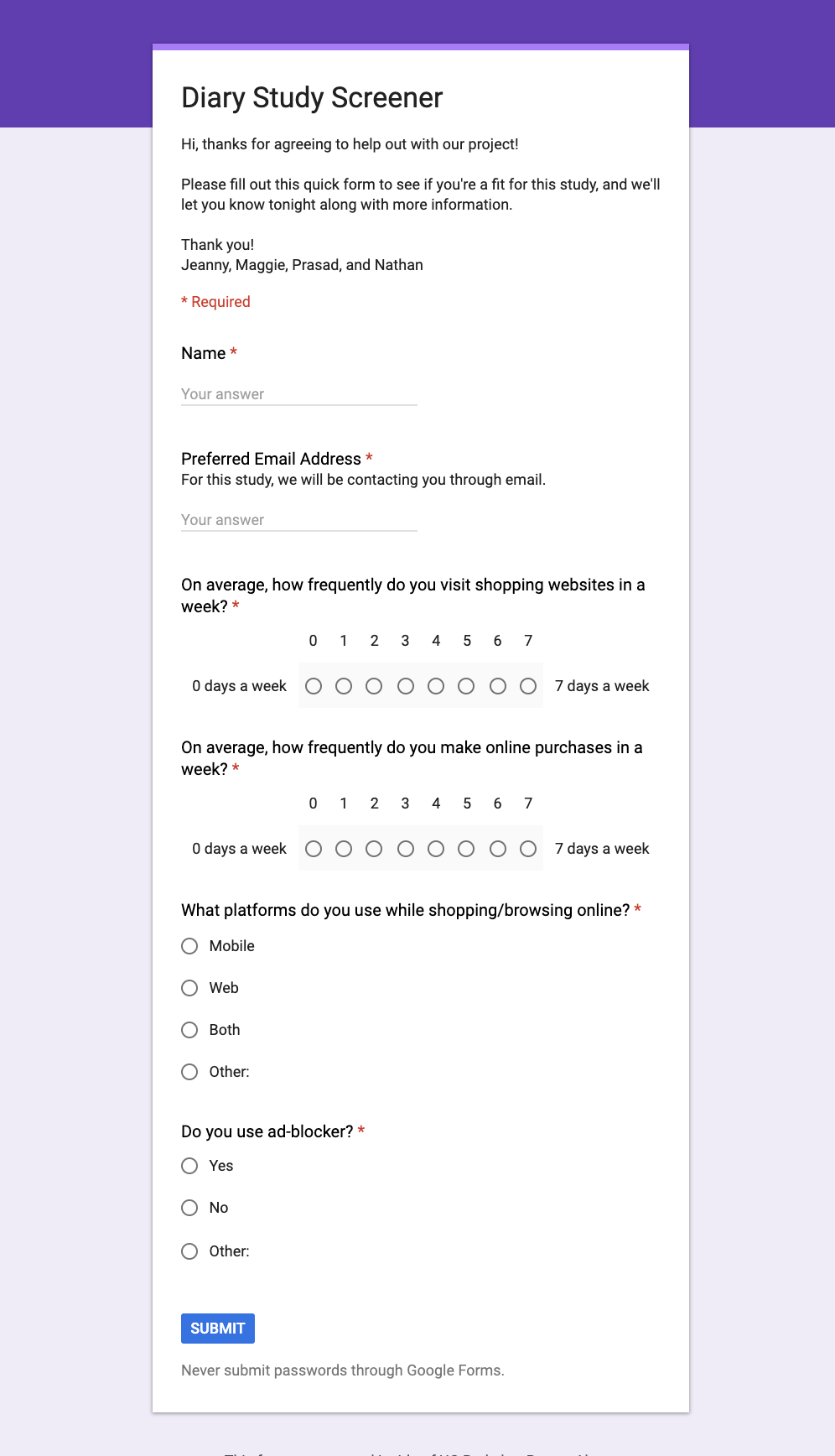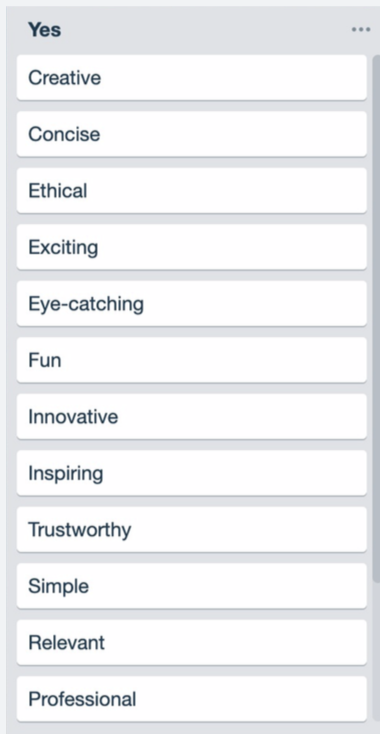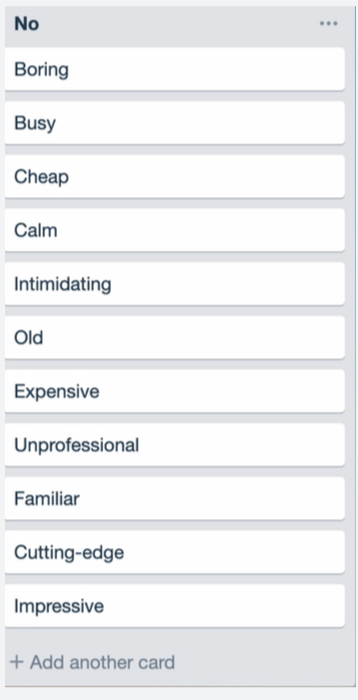Good Ad Experiences
UX RESEARCH
Keywords: Privacy, Targeted Ads, Online Shopping
GOAL
To help our industry client understand what a good online shopping ad experience is, and how it affects users’ attitudes and behaviors.
TEAM
Jeanny Xu, Maggie Chen, Prasad Gaikwad, Nathan Khuu
MY ROLE
︎ Secondary Research
︎ Card Sort / Reaction Cards
︎ Diary Studies
︎ Interviews
CONTEXT
Scope & Research Goal
We started off with the high-level questions asked by our client: What makes up a "good" ad experience in online environments? How does it make people feel and what actions do these ads lead to?
We conducted initial research on online ad experiences, and found industry research reports like Coalition for Better Ads and Google’s Ad Experience Report. They outlined forms and contents of an ad that would evoke negative emotions, and gave advice on how to avoid that.
After discussion with our client, our team narrowed down the scope to users’ attitudes and actions. We chose to focus on shopping ads, because it is easier to define, and generally, they are representative of ads that an average user would encounter online.
What components (ad content, ad creative, ad contexts) define a good ad experience? How do good ad experiences affect users’ attitudes and behaviors?
With a focus on users with the following profile:
- Adult (over 18), comfortable with technology
- Frequent online shopper - at least 3 times/week, any form of online shopping including browsing and purchasing.
METHODS
Screening & Selection
We recognized that “good” is a generic term that can take on different meanings to different people, so we selected three research methods that will provide us with rich qualitative data, allow us to ask open-ended questions, and give participants opportunities to define what’s “good” to them.
Participants were recruited from our social circles, and those selected to participate passed an initial screening survey to ensure that they match our targeted user profile.
This method provided us with rich qualitative data collected from participants in situ. It helped us understand users’ thoughts and behaviors when they encounter ads while browsing, and served as a starting point to get a grasp of how people view and interact with shopping ads.
Participants were recruited from our social circles, and those selected to participate passed an initial screening survey to ensure that they match our targeted user profile.
Diary Study
This method provided us with rich qualitative data collected from participants in situ. It helped us understand users’ thoughts and behaviors when they encounter ads while browsing, and served as a starting point to get a grasp of how people view and interact with shopping ads.

Length of study: 5 days
Number of participants: 18 (3 dropped, 15 in effect)
Compensation: Choice of beverage (up to $5)
Procedure: Participants upload screenshots of ads that they consider as a good ad experience, and answer related questions via Google Form on a daily basis.
Outcome: ~70 entries in total, 3 themes seem to emerge after synthesis:
We then followed up with participants from the diary studies who have provided interesting insights, and conducted a more in-depth interview to collect deeper insights about their experiences.
Length of study: 30 min - 1 hr each
Number of participants: 6
Procedure: Participants were asked to elaborate on their diary study entries, and then discuss more broadly their experiences with online shopping ads.
Outcome: Insights around people’s preferences for visuals, company values, and creepy/relevant ads:
Immediately following the interview, we asked participants to arrange adjectives (adopted from Microsoft Desirability Toolkit and our diary study responses) to define aspects of a good ad experience they value and prioritize.
Length of study: 5 - 10 min each
Number of participants: 6
Procedure: A list of 26 descriptive words were prepared in alphabetical order (including words that are positive, ambiguous, and negative) on Trello in the “Unsorted” pile. Participants were instructed to:
Outcome:
Top adjectives for current ad experiences: Familiar, Busy, Relevant, Simple
Top adjectives for ideal ad experiences: Ethical, Trustworthy, Eye-catching
Number of participants: 18 (3 dropped, 15 in effect)
Compensation: Choice of beverage (up to $5)
Procedure: Participants upload screenshots of ads that they consider as a good ad experience, and answer related questions via Google Form on a daily basis.
Outcome: ~70 entries in total, 3 themes seem to emerge after synthesis:
- Ad Creative: Visual appeal
“The bright purple color definitely made the ad stand out on the website that I was on, and the simple graphics gave off a bold and playful vibe.” - Ad Content: Straightforward-ness
“The caption was very catchy [...] and the demonstration was also short and sweet.” - Ad Context: Relevancy
“I already have the matching palette with this and now I want the new release so I can have the collection. Honestly not even like super great ad in and of itself but it’s so ducking targeted.”
Interview
We then followed up with participants from the diary studies who have provided interesting insights, and conducted a more in-depth interview to collect deeper insights about their experiences.
Length of study: 30 min - 1 hr each
Number of participants: 6
Procedure: Participants were asked to elaborate on their diary study entries, and then discuss more broadly their experiences with online shopping ads.
Outcome: Insights around people’s preferences for visuals, company values, and creepy/relevant ads:
- People have different preferences for ad creatives due to personal aesthetic preferences.
- People care about company values and ethical practices.
- Creepiness and relevancy come hand-in-hand, and there are accompanying concerns about privacy.
Card Sort (Reaction Cards)
Immediately following the interview, we asked participants to arrange adjectives (adopted from Microsoft Desirability Toolkit and our diary study responses) to define aspects of a good ad experience they value and prioritize.
Length of study: 5 - 10 min each
Number of participants: 6
Procedure: A list of 26 descriptive words were prepared in alphabetical order (including words that are positive, ambiguous, and negative) on Trello in the “Unsorted” pile. Participants were instructed to:
- Consider their current experiences with online shopping ads, and sort the words in “Unsorted” into “Yes” and “No” piles according to whether they can be used to describe their experiences.
- Rank top 3 words in the “Yes” pile
- Explain each word choice and why they were chosen
- Repeat Step 1-3 while considering their ideal experience with online shopping ads
Outcome:
Top adjectives for current ad experiences: Familiar, Busy, Relevant, Simple
Top adjectives for ideal ad experiences: Ethical, Trustworthy, Eye-catching

Current ad experience


Ideal ad experience
INSIGHTS
Relevant vs. creepy ads are distinguished by being shown exact tracking of past browsing history vs. new relevant information.
Personalized new information is good:
- Likely to act on relevant ads, e.g. clicking or taking mental notes
Exact tracking of viewing history is creepy:
- Participants notice when their online viewing histories has been tracked
- Dislike for “creepy” ads
- Might evoke stronger reactions like avoid shopping with the company/site in the future, using incognito for searches
Company values and ethical practices matter!
Company practices and values affect user behaviors.
Qualities like honesty and ethical values are important to users.
People have varying preferences for visual presentations/ad creatives.
Some prefer ads that are concise and to-the-point:
- Not too busy or stressful to look at
- E.g. flashing ads, quickly switching between multiple slides or images
Some prefer ones that are fun and enjoyable:
- Visually appealing
- Colorful and eye-catching
RECOMMENDATIONS
Bring awareness to new items relevant to past preferences
Don’t immediately advertise the exact same product/service that were previously searched.
Make it concise and to-the-point
Highlight objective points (e.g. price, use cases, quick demos) and show honest representations of the product/service.
Explore the idea of targeting based on ad creative
No clear consensus on what a good ad looks like - why not present them based on their aesthetic preferences?